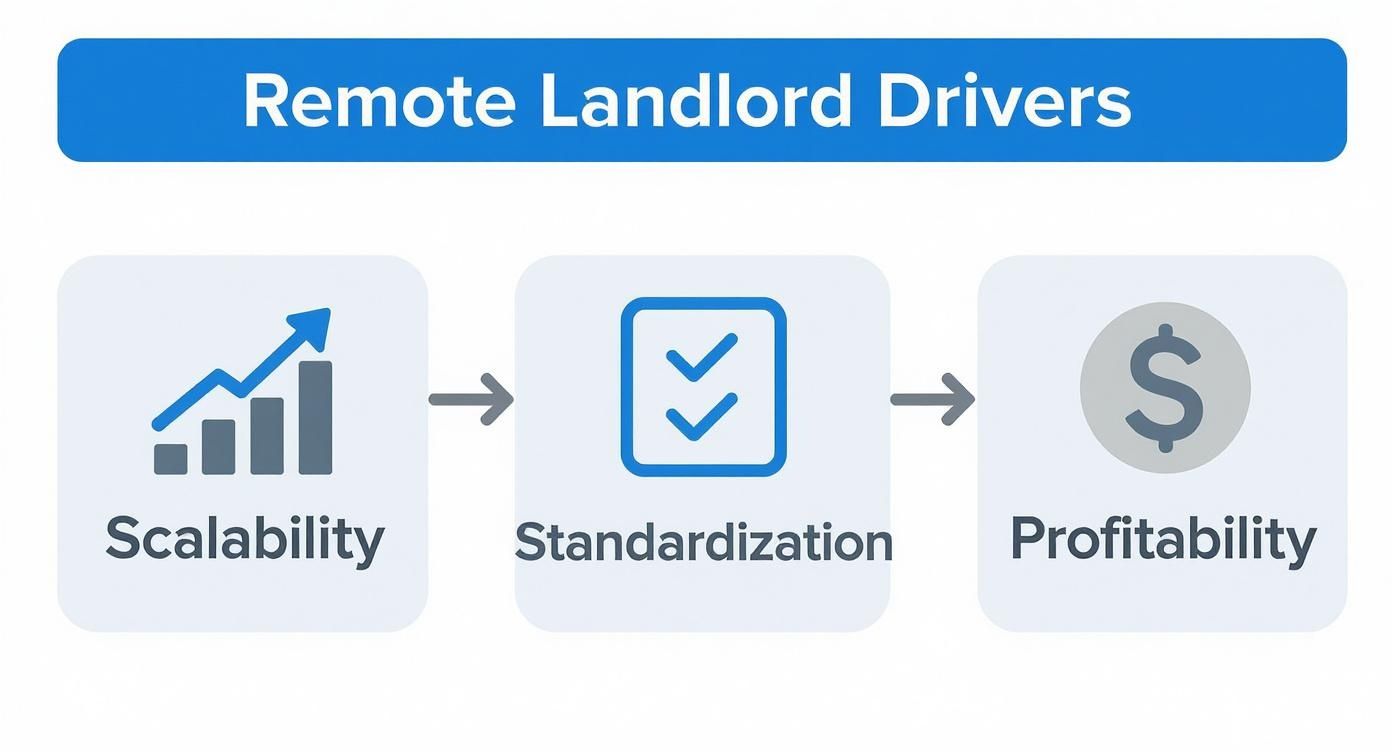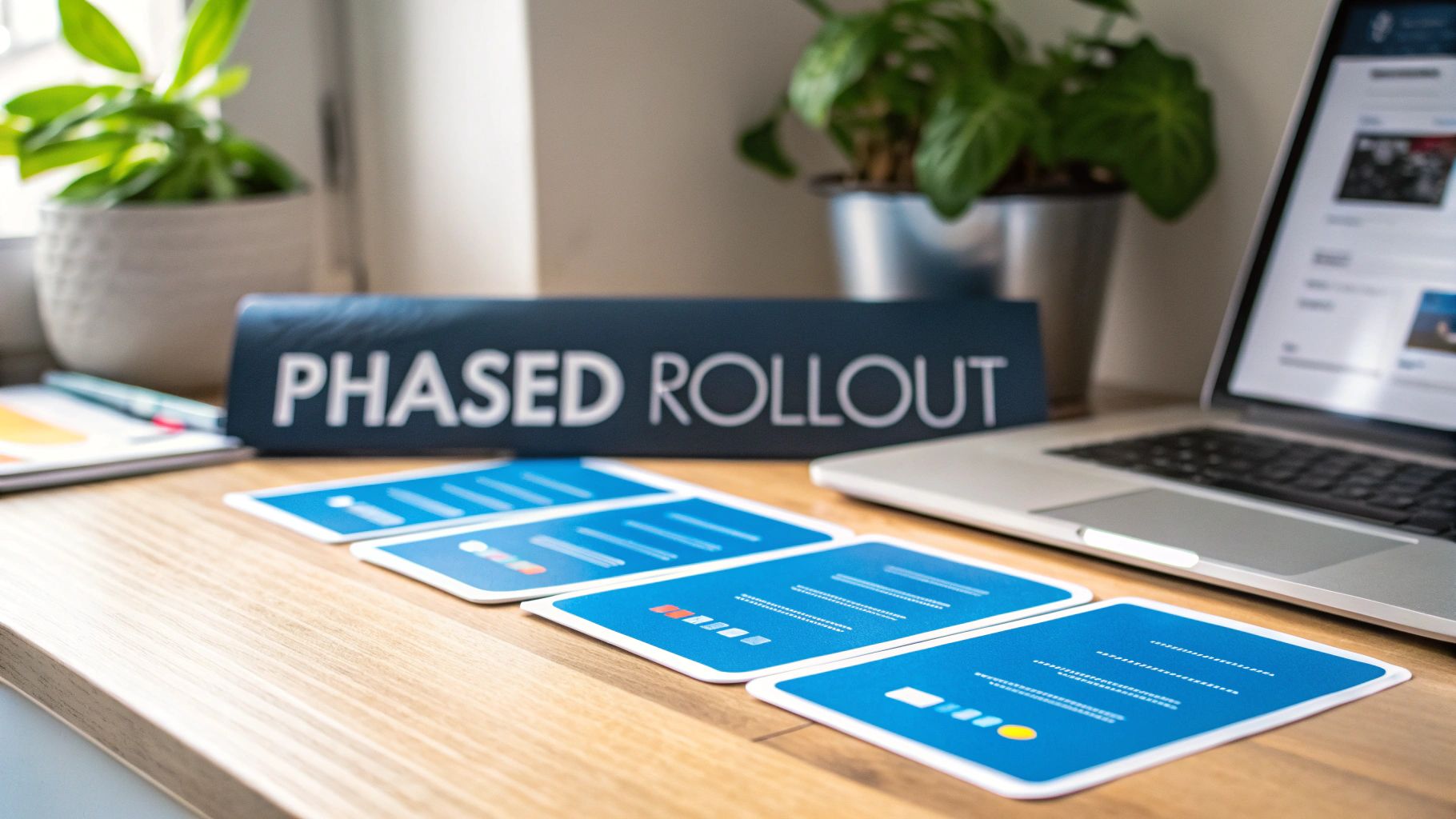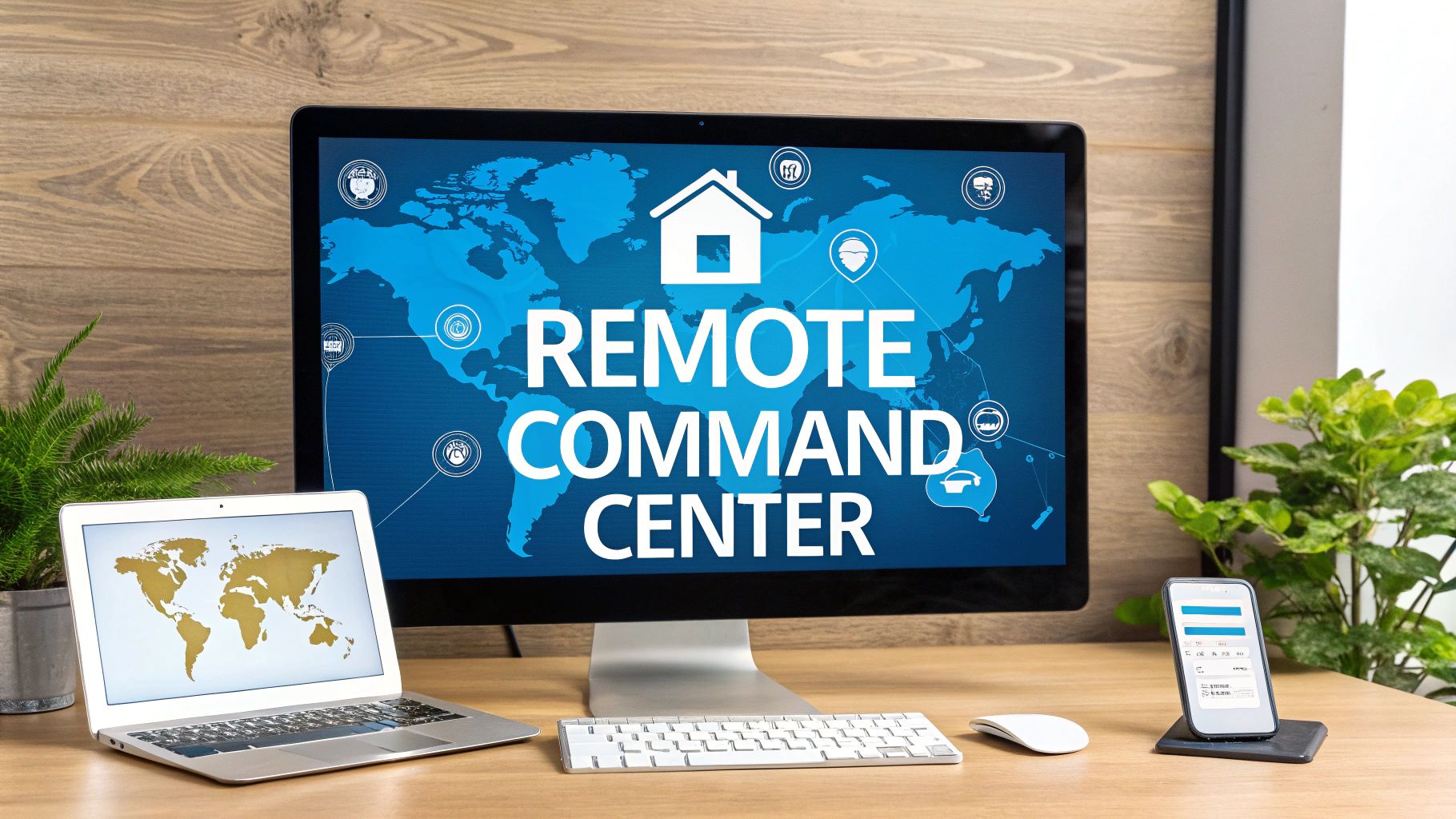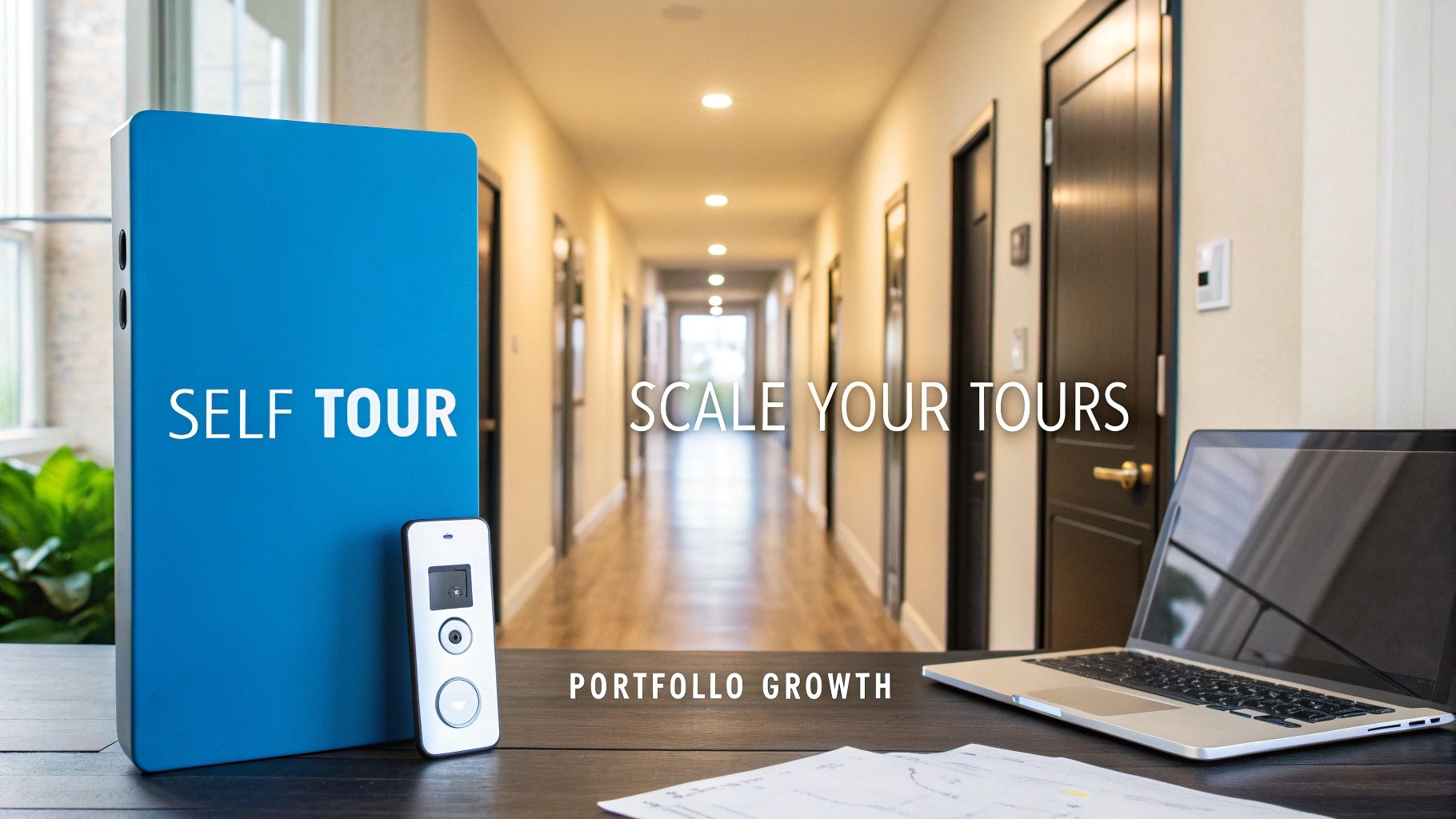For an operations director managing a scattered portfolio, a remote landlord system is your digital command center. It’s a technology platform designed to automate and standardize leasing, maintenance, and tenant communication across hundreds or thousands of doors, eliminating the need for onsite staff at every location. If you're focused on scaling from 500 to 5,000+ units, these systems are the core infrastructure for profitable growth.
The Operational Shift to Remote Management
Managing a growing portfolio of single-family rentals or multifamily properties without onsite staff using a traditional, boots-on-the-ground model is an operational bottleneck. It’s a logistical nightmare that kills efficiency. The conventional approach breaks down completely when properties are geographically dispersed, leading to inconsistent processes, high overhead, and significant revenue leakage from extended vacancies.
This is the precise challenge that remote landlord systems solve, driving a fundamental operational shift.
Migrating to a remote-first operation isn't a trend; it's a strategic response to market demands and the relentless pressure for better financial performance. As a portfolio scales, minor manual inefficiencies compound, directly eroding your net operating income (NOI).
What’s Driving Large-Scale PMs to Remote Operations?
The drivers for this industry-wide move are tied directly to the metrics that define portfolio performance:
- Scalability Demands: You can't hire a new leasing agent for every 50 properties added to the portfolio. Remote systems provide the operational backbone to manage thousands of units with a lean, centralized team, directly improving your cost per door.
- Process Standardization: Ensuring every lead receives the same immediate, high-quality response is impossible with siloed, multi-market teams. A centralized platform enforces a consistent, high-performance workflow for every property, regardless of location.
- Revenue Impact Focus: The most critical driver is the urgent need to reduce vacancy loss. Every day a unit sits vacant is lost revenue. Across a 1,000+ unit portfolio, this translates into a significant financial drain. Speed-to-lease is paramount.
The property management industry has rapidly evolved to meet these demands. By 2025, an estimated 67% of property management companies are expected to leverage specialized software, with 48% having already adopted automated systems for lease management. It's about replacing outdated, manual processes with efficient, technology-driven solutions. For property managers aiming to optimize operations, transitioning to self-management with remote tools is a logical progression.
A remote landlord system transforms your operating model from reactive and location-dependent to proactive and centralized. It’s not just about managing from a distance; it's about systemizing every stage of the leasing cycle to maximize efficiency and NOI at scale.
Ultimately, implementing a robust remote system is a strategic imperative to protect and grow your portfolio's financial health. It directly addresses the metrics that matter: cost per door, lead-to-tour conversion rates, and—most critically—Days on Market (DOM).
Building Your Digital Command Center
Imagine trying to manage a 1,000-unit portfolio with a thousand different manual processes. That’s the reality for many large-scale property managers operating with disconnected systems. An enterprise-grade remote landlord system consolidates those functions into a single, powerful digital command center, providing complete visibility and control over every property, no matter the location.
This is about building a scalable operational hub. The core of this command center focuses on the functionalities that drive enterprise growth: automated leasing workflows that engage prospects instantly, centralized communication that logs every interaction, and digital maintenance coordination that dispatches vendors without manual intervention.
Automating the Speed-to-Lease Funnel
The single most critical function of your digital command center is to compress the lead-to-lease timeline. Every manual touchpoint is a delay that costs real money. For a large-scale portfolio, these micro-delays create a massive drag on revenue.
The solution is to automate the entire prospect journey, from initial inquiry to a booked tour. Modern remote landlord systems achieve this through key technologies:
- Instant Lead Response: When a prospect inquires, an AI-powered system responds immediately, 24/7. The property manager who responds first wins the tour. This single automation can significantly lift your lead-to-tour conversion rate.
- Automated Pre-Screening: The system asks critical qualifying questions upfront, ensuring only serious, qualified prospects advance to the next stage.
- Self-Service Tour Scheduling: Eliminate the back-and-forth emails. Prospects see available tour times and instantly book a showing—whether it’s a self-guided tour, an agent-led showing, or a virtual walkthrough.
This level of automation is what separates a basic tool from a true enterprise solution built for remote operations. To see this technology in action, you can learn more about the benefits of using an AI leasing assistant and how it transforms lead management.
This graphic illustrates the core business drivers that make such a system essential for large portfolios.

As you can see, the drive for scalability necessitates process standardization, which is the most direct path to improving profitability across your entire portfolio.
Eliminating Onsite Dependencies
A true digital command center fundamentally redefines your staffing model. It eliminates the need for costly onsite staff whose primary role is managing access and answering basic inquiries. Technologies like keyless entry systems provide secure, remotely managed access for self-guided tours, maintenance vendors, and resident move-ins, all controlled from your central hub.
By centralizing leasing operations, you transform your team's function from reactive, location-based tasks to strategic, high-value oversight. Your team members become portfolio analysts, not just key-handlers.
This shift directly impacts your cost per door optimization. Instead of budgeting for staff across dozens of locations, you invest in a centralized team equipped with technology to manage a far larger volume of properties. The system handles repetitive, time-consuming tasks, freeing your team to focus on owner relations, market analysis, and strategic growth.
Manual vs. Automated Systems: Operational Impact on Large Portfolios
To fully grasp the transformation, a side-by-side comparison is illuminating. For a large portfolio, these differences represent a fundamental shift in operational capacity and financial performance.
This table shows how automation systematically removes the bottlenecks that inhibit profitable portfolio growth.
By building a robust digital command center, you're not just managing properties remotely; you're engineering a scalable, repeatable, and highly profitable operational model—the framework required to add hundreds of new doors without corresponding increases in operational costs.
Turning Vacancy Loss into Revenue Gain
Every day a rental unit sits empty, it directly impacts your bottom line. For a single property, it’s an annoyance. For a portfolio of thousands of units, that slow leak of rent loss compounds into a significant financial drain. It's the single biggest obstacle to maximizing portfolio performance.
The cost is tangible and easily calculated with a formula every portfolio manager should have top-of-mind:
Vacancy Cost Formula: ([Average Monthly Rent / 30 Days] * Vacant Days) * Total Vacant Units
Let's quantify this. For a 2,000-unit portfolio with an average rent of $1,800, a typical 30-day vacancy period isn't a rounding error—it represents a massive revenue gap and a critical opportunity for recovery. This is precisely where remote landlord systems deliver their greatest ROI.

Plugging the Revenue Leak with Speed-to-Lease
How do these systems stop the financial bleeding? They attack the root cause of long vacancies: the time it takes to move an interested prospect from inquiry to signed lease. A remote system collapses this timeline by automating the most time-sensitive steps.
- Instant Lead Engagement: No more "lead lag." AI-powered responders engage every inquiry in under two minutes, 24/7. You capture high-intent prospects before your competition even sees the notification.
- Same-Day Showing Capability: Today's renters expect speed. These systems allow prospects to book a showing for the same day, capitalizing on peak interest and accelerating the decision-making process.
- Streamlined Digital Applications: The moment a tour concludes, the system can automatically deliver a digital application link to the prospect's phone, capturing their commitment while the property is still top-of-mind.
This is about transforming a cumbersome, multi-day process into a seamless, same-day transaction. It's the difference between securing a qualified tenant and losing them to a more agile competitor.
Mini Case Study: ROI for a 2,000-Unit Operator
Consider a property management company with 2,000 scattered single-family rentals. Their average Days on Market (DOM) was 30 days, primarily due to the logistical challenges of coordinating showings across a wide geographic area.
Upon implementing a remote landlord system with an on-demand showing agent network, their process was revolutionized. Leads received instant responses and could book agent-led tours within hours, not days.
The result? Their average DOM plummeted from 30 to just 18 days. The financial impact was staggering.
- Days Saved Per Unit: 12
- Daily Rent (at $1,800/month): $60
- Revenue Recovered Per Unit: $720
- Total Annual Revenue Recovery (assuming 50% turnover on 2,000 units): $720,000
This isn't an abstract "efficiency gain." It's a direct, measurable revenue recovery that demonstrates the powerful ROI of a well-implemented remote system. The data is clear: fast vacancy filling remains the top cost-reduction strategy for 74% of property managers. This technology is the most effective tool for achieving that goal.
Of course, minimizing costs also means retaining tenants. Proactively understanding landlord pest control responsibilities and addressing issues swiftly prevents turnover and further vacancy loss.
Choosing a System Built for Scale
Not all remote landlord systems are created equal. A platform suitable for managing 50 units will collapse under the operational weight of a 5,000-unit, multi-market portfolio. For an operations director, system selection is a strategic decision about core architecture: can it handle your growth trajectory?
The wrong choice creates data silos, frustrates your team, and establishes an operational ceiling that makes profitable expansion impossible. The right system becomes the engine of your growth, enabling you to standardize excellence as you add new doors.
Foundational Criteria for Enterprise Success
When evaluating platforms, look beyond marketing features and focus on the non-negotiable pillars that support a large-scale operation.
Your evaluation framework should be built around these core needs:
- Proven Scalability: The vendor must provide evidence that their system is successfully used by clients with portfolios of a similar or larger size. Request case studies and references from companies managing over 1,000 units.
- Robust API Integrations: A remote landlord system must function as part of your tech stack, not an isolated island. It requires a deep, two-way API integration with your core Property Management Software (PMS)—like AppFolio, Yardi, or RealPage—to ensure seamless data flow.
- Stringent Security Protocols: The platform will handle sensitive owner, tenant, and property data. It must adhere to high-level security standards, including data encryption, access controls, and compliance certifications.
A well-integrated system connects every part of your leasing operation, from lead source to your core PMS.
This seamless information flow eliminates manual data entry, a primary source of errors and wasted time at scale.
Customization and Standardization
A key challenge in multi-market management is maintaining process consistency. A workflow for single-family rentals in one state may need adjustments for small multifamily buildings in another.
A true enterprise-level system provides the flexibility to customize without sacrificing standardization. Look for platforms that allow you to build unique process templates based on property type, market, or owner requirements. This ensures every lead receives the correct follow-up sequence and every showing adheres to brand standards, regardless of location. This is a critical component to help you scale your team on-demand while maintaining quality control.
The goal isn't just to manage remotely; it's to create a repeatable, high-performance leasing machine that you can deploy in any new market you enter.
The Buyer’s Checklist for Long-Term Partnership
Before committing, use this checklist to assess potential vendors. You are selecting a long-term partner, not just buying software.
- Implementation Roadmap: Do they provide a clear, phased implementation plan with a dedicated project manager? A vague setup process is a major red flag for an enterprise rollout.
- Support and Training: What is their support model? For an enterprise client, a dedicated account manager and comprehensive training resources are essential for successful team adoption.
- Total Cost of Ownership (TCO): Look beyond the subscription fee. Inquire about implementation costs, integration fees, and charges for premium support or additional users to understand the full financial commitment.
Your Phased Implementation Roadmap
Rolling out new technology across a large, multi-market portfolio can feel like changing the engine on a moving train. A misstep can disrupt operations, frustrate your team, and negate the expected ROI. The solution is a strategic, phased rollout designed to build momentum and ensure adoption.
This structured approach transforms a daunting project into a series of manageable wins, ensuring your remote landlord system delivers value from day one.

Phase 1: System Integration and Data Migration
This is the foundational stage. The first priority is establishing a seamless, two-way data sync between your new system and your core Property Management Software (PMS). This avoids data silos and ensures everyone works from a single source of truth for listings, leads, and resident information.
Critical Action Items:
- API Connection: Work with the vendor's technical team to connect the API to your PMS, carefully mapping critical data fields for properties, units, and leads.
- Data Migration: Execute a clean transfer of all active listings and lead pipelines to ensure no disruption to ongoing leasing activities.
- KPIs to Track: Target a 99.9% data sync accuracy rate. Success means zero operational downtime during the transition.
Phase 2: Process Standardization and Workflow Automation
With the technical infrastructure in place, it's time to build the automated workflows that drive efficiency. Translate your team's best practices into standardized, repeatable processes within the system.
Start with a pilot program. Select a single market or a portfolio of 50-100 units to test and refine the workflows. This provides a controlled environment to gather real-world feedback, identify bottlenecks, and prove the system's value on a small scale, which is crucial for securing company-wide buy-in.
Phase 3: Team Training and Onboarding
Technology is only effective if your team uses it proficiently. This phase focuses on empowering your leasing agents, portfolio managers, and support staff. Training must be role-specific, demonstrating how the new system makes each person's job easier and more effective.
Onboarding Should Include:
- Workflow Training: Conduct hands-on sessions covering new lead management, tour scheduling, and reporting processes.
- Resource Hub: Create an accessible knowledge base with video tutorials, FAQs, and quick-reference guides.
- KPIs to Track: Monitor the team adoption rate—the percentage of staff actively using the system daily. A successful rollout should see a significant decrease in support tickets after the first month.
The objective is to change habits for the better. A successful rollout makes your team feel empowered by new tools, not burdened by them.
Phase 4: Performance Benchmarking and Optimization
Once the system is live across your portfolio, the final phase is a continuous cycle of measurement, learning, and improvement. Benchmark your new performance against historical metrics to prove ROI and identify opportunities for further optimization.
Regularly analyze your lead-to-tour conversion rates, average days on market, and cost per showing. Use these insights to refine automated follow-ups, adjust marketing spend, and provide targeted coaching to your leasing teams. This transforms your remote landlord system from a static tool into a dynamic engine for growth.
The Future of Automated Portfolio Management
Implementing a remote landlord system isn't just about solving today's operational challenges; it’s about positioning your portfolio for the next decade of property management. The future isn't just remote; it's automated, intelligent, and predictive.
The next evolution of these platforms is driven by artificial intelligence and machine learning. Imagine a system that anticipates maintenance needs by analyzing historical data to predict which HVAC units are likely to fail before a heatwave. This allows for proactive preventative maintenance, avoiding costly emergency repairs and improving resident satisfaction.
The Rise of Predictive Operations
This predictive capability extends far beyond maintenance. Forward-thinking remote landlord systems are integrating dynamic pricing engines, similar to those used by the airline industry. These tools will analyze real-time market data, local demand, and competitor vacancy rates to recommend optimal rental pricing, maximizing revenue for every unit.
Furthermore, tenant communication will become hyper-personalized. AI will tailor messages based on individual resident behavior, boosting engagement for everything from lease renewals to community announcements.
The paradigm is shifting from reactive management to a proactive, predictive model. The companies that master this today will lead the digital-first rental market of tomorrow.
Integrating the Smart Home Ecosystem
The final piece of this vision is the seamless integration of IoT and smart home technology. Smart locks, thermostats, and leak detectors will feed live data directly into your central dashboard. This provides an unprecedented level of remote control, allowing you to monitor property security, manage energy costs during vacancies, and address a small water leak before it becomes a catastrophe.
The rental market is vast and competitive. With millions of property owners managing a share of the 20.5 million rental units in the U.S., technology is the key differentiator for efficient management at any scale.
By exploring what’s next in the future of property management, forward-thinking companies are not just keeping pace; they are defining the new standard for profitable, large-scale portfolio operations.
Frequently Asked Questions
When considering a major operational shift, key questions arise. Here are direct answers for operations directors and portfolio managers.
How Do Remote Landlord Systems Integrate With My Current PMS?
Enterprise-grade systems are built for deep integration. They don't just "connect" with platforms like Yardi, AppFolio, or RealPage; they establish a true two-way sync via robust APIs.
This means lead information, tour schedules, and leasing statuses are always consistent across your entire tech stack. It eliminates manual data entry, preventing the costly errors that inevitably occur at scale.
When evaluating a platform, confirm they have a well-documented API and a dedicated technical support team to manage the integration. This is an essential requirement for maintaining data integrity across your operation.
Can One Remote System Manage Both SFR and Multifamily Units?
Yes. This flexibility is a core strength for operators with diverse portfolios.
- For Scattered Single-Family Rentals: These systems excel at coordinating on-demand showings across a large geographic area, eliminating the need for neighborhood-specific staff and dramatically improving your cost-per-door.
- For Multifamily Buildings without Onsite Staff: You can automate access for self-guided tours, standardize the leasing experience across all units, and centralize communications. This is a game-changer for operating scattered multifamily assets efficiently.
The key is a platform that allows you to configure different workflows by property type, ensuring the system adapts to your operational model.
What Is the Typical ROI I Can Expect?
The return on investment is realized in several key areas, with the most immediate and significant impact coming from reduced vacancy loss by slashing your Days on Market (DOM).
Consider the financial impact: reducing DOM by just 5 days across a 1,000-unit portfolio with an average rent of $1,800 recovers $300,000 in annual revenue that was previously lost.
Beyond vacancy reduction, ROI comes from operational efficiency gains. This includes a lower cost per showing (especially when using an on-demand agent network) and higher lead-to-lease conversion rates. As conversion rates improve, your marketing cost per lease decreases, further enhancing profitability. A powerful system pays for itself by plugging the financial leaks in your leasing funnel.
Ready to slash your Days on Market and transform your remote operations? Showdigs is the first AI-backed leasing automation platform built to accelerate your entire leasing funnel. Discover how Showdigs can help you turn vacancies into revenue today.






